|
Did you know that the #1 tool most people use for cleaning bacteria from their teeth, gums, and mouth, already contains millions, possibly trillions, of bacteria? If you leave your toothbrush in the bathroom and never disinfect it, you’d better read this article.
In his book, Why Your Toothbrush May Be Killing You Slowly, James Song, a biochemist from Wisconsin University, suggests that a range of serious health problems, including heart disease, stroke, arthritis and chronic infections, could be linked to unhygienic toothbrushes. Further research by Manchester University found that the average toothbrush contained around ten million germs, including a high percentage of potentially fatal bacteria such as staphylococci, streptococcus, E. coli and candida. Other studies have shown that over time, a single toothbrush can be the breeding ground for trillions of bacteria specimen. There are many ways these bacteria latch on to toothbrushes: Use from an infected user, spray from a flushing toilet, a damp environment that allows the bacteria to breed and grow, and just a general lack of oversight. Think about it for a moment; would you leave your eating utensils in the bathroom, use them over and over again, and never wash them? As bad as it sounds, overcoming this potential time bomb is not complicated. Below are Dr. Moorhead’s 5 simple tips to keep your toothbrush bacteria free.
If you have any questions or would like further advice on disinfecting your toothbrush, please contact us using one of the methods below, or ask us at your next appointment.
1 Comment
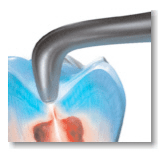 Ever wonder how dentists know whether there is a cavity in a tooth? We use x-rays to look for cavities in-between teeth, but how does a dentist know if there’s decay in the grooves of your teeth? In the past, the dental profession has traditionally used a dental explorer to feel for soft spots in the grooves of teeth. Unfortunately, there was often some guesswork involved. Before fluoride was added to our community water supplies to help prevent cavities, decay would often be a large hole and easy to spot. Since fluoride has been used, dental decay in the grooves of teeth now is very narrow and more difficult to diagnose. A newer technology that is now available in our office is a laser device called a Diagnodent. This device shines a laser light into the grooves of your tooth, and a numeric value is displayed that indicates how much decay is present. It’s completely painless, and even very small cavities can be detected at their earliest stage, so that decay can be caught before more tooth structure is damaged. Cavities can start in the grooves of teeth even before a child’s tooth fully appears. In almost 90% of molar teeth, the grooves aren’t formed completely. A dental sealant can be placed soon after the tooth erupts to protect these incompletely formed grooves in the teeth from developing cavities. 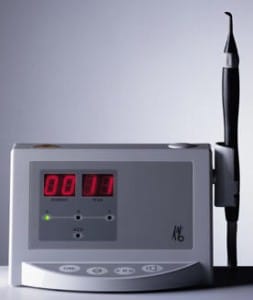 In our office, we use the Diagnodent laser to tell us if a sealant can be used. When the Diagnodent’s digital reading displays a reading of 23 or higher, we know there is an actual cavity present that requires a filling. For a reading of 22 or less, we can place a sealant to keep the tooth from getting a cavity in the first place. For more information on the Diagnodent, or to schedule your next appointment, contact us today. You’re seeing commercials on television that talk about a product’s ability to reverse cavities. So can these products really work? And what works best? First a little bit of background. A tooth actually develops a “cavity” when bacteria eats through the outer enamel layer of the tooth and gets into the softer dentin layer that lies below the enamel. In your mouth, these demineralized areas, or “pre-cavities” look like opaque white or brown spots, as shown in the picture below. We’ve known for several years that you can use fluoride to reverse a pre-cavity, but it requires repeated regular applications of fluoride to accomplish this reversal. Two of the best ways to accomplish this are with application of fluoride varnishes or the daily use of custom fluoride trays at home. Fluoride varnish is a highly concentrated temporary dose of fluoride. The varnish holds fluoride close to the tooth surface for a longer period of time than other concentrated fluoride products. The varnish, usually tooth colored, is applied by a dental professional. When the varnish is used repeatedly, it can actually reverse the pre-cavity by remineralizing the tooth. 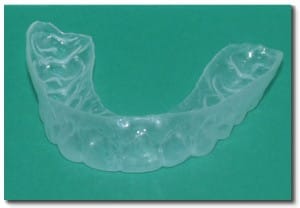 Custom fluoride trays look similar to bleaching trays or whitening trays, but are specifically designed to cover your teeth completely at the gum line. They are fabricated to fit directly over your upper and lower teeth, and are used to hold a few drops of concentrated fluoride on the teeth. For about the cost of having one cavity filled, the custom fluoride trays provide you with a way of doing a professional strength fluoride treatment every day. To use the custom fluoride trays, we recommend the following regimen:
There are some newer products that are even more effective at reversing pre-cavities. A product called MI Paste can reverse the pre-cavities and often reverse the opaque white spot caused by the pre-cavity. MI Paste works by releasing calcium and phosphate ions into your tooth enamel. It can be brushed on, or can be worn in the custom fluoride trays already mentioned. There are many effective tools for fighting cavities before they start. Give us a call today so that we can help give you the smile you want.  Many people in our area are not covered by dental insurance. Several times a month, we hear patients wondering if they should buy dental insurance coverage before they proceed with their dental work. This article will help you understand how dental insurance coverage works, and in what situations it can benefit you. We all know that insurance companies have developed a reputation for putting themselves before their customers. In reality, the customer for a dental insurance company is the employer who purchases a group insurance plan. With the pressures on business from the high costs of medical insurance, dental insurance plans have suffered badly for several years. In addition, more employers are offering dental insurance to their employees only if the employee pays for all or part of the premium. So when is dental insurance advantageous? Dental insurance is probably an excellent help if your employer covers the premium completely. However, unlike medical insurance, most dental insurance plans only cover a maximum of $1,000 per year. You may find it interesting that when the first dental insurance plans were offered around 1960, the average annual benefit was … $1,000 a year. So accounting for inflation since 1960, today’s plans over less than $150 in 1960 dollars. For patients that come into our office with more expensive problems, I like to tell my patients to consider their dental insurance as a $1,000 off coupon, rather than dental “insurance.” But let’s say you have to pay for part or all of your insurance premium, or your employer doesn’t offer dental insurance and you are thinking about purchasing an individual plan. For the insurance company to make a profit, they must charge enough premiums to cover your dental work, plus administrative fees, plus their profit. If you must pay all of the premiums on your own, this makes it unlikely you can come out ahead. If your employer pays for part of your benefits, the dental insurance might still be beneficial, but you’ll have to do some calculations. Take some time to calculate how much you’ll pay in benefits per year, and compare that amount to the cost of your “two free cleanings and exams.” In addition, if you are enrolling for the first time, you may have a waiting period before major work is completed, so that you’ve paid more insurance premiums before getting to enjoy many of the benefits of the plan. See also, Dr. Moorhead's aticle about the benefits of Health Savings Accounts that can provide tax-deductible benefits to pay for medical and dental expenses. In addition, don’t forget that our office offers extended payment arrangements using several outside firms, so that your dentistry can be handled affordably. Questions and Observations That Will Help You Choose a Dentist
Many situations can occur that may require finding a new dentist, such as moving, having a dentist retire, or needing special services your present dentist can’t provide. Although we all know that proper dental care is vital to good health, most of us don’t know how to choose a good dentist. It can be difficult to know what questions to ask and what things to observe in the process of choosing a good dentist. You will want to know both how the dentist treats you as a person and how he treats your mouth. Following are some key questions to ask and observations to make in the process of making your choice. QUESTIONS TO ASK YOUR PROSPECTIVE DENTIST
Some things can only be learned by observation or by asking former or present patients for their opinions. Here are some things that are important to learn:
Of the three ways you can lose teeth, periodontal disease – also referred to gum disease or gum and bone disease – causes the most tooth loss in adults. Periodontal disease is a silent disease until it reaches advances stages, so without a routine dental exam, you could have it but not know it. Of the half of adult’s that don’t go to the dentist regularly, 80% have serious periodontal disease by age 40. The word “periodontal” describes the structures around that tooth that give it support – the gingival (gums), the bone, and the fibers in-between. Signs that show you may have periodontal disease include:
First, let’s take a look at the stages of periodontal disease. This first photo shows an example of healthy gums. The gingival is light pink and flat, and the diagram shows the bone in-between teeth with proper support. Gingivitis is the first stage periodontal disease. Shown in the next photo, gingivitis is a completely reversible disease. The gums are red and swollen, but there is no damage to the bone support. In this third photo, an early stage of periodontitis is shown. You can see the gums pulling away from the teeth as they are losing their bone support. The teeth are sometimes more sensitive where the roots are partially exposed, but often there are no symptoms even at this stage of the disease. Symptoms usually don’t develop until severe bone involvement, so shown here, when the teeth become loose and sore. By this time, it’s often too late to save the involved teeth. To check the health of your gums, your dentist gently slides a measuring probe under your gums. Measurements are made several places around each tooth to show where the gums attach to your tooth, and if there is any bleeding or pus present. If the periodontal support around your tooth is in good shape, the farthest that the probe should be able to measure is 3 mm, or 1/8 inch. This is the farthest that a toothbrush and floss can clean under the gums adequately. A measurement of 4mm or greater demonstrates evidence of periodontal disease. Dentists refer to these areas as “periodontal pockets.” Other signs of periodontal disease include bleeding gums and receding gums.
The actual cause of periodontal disease is bacteria that live in these periodontal pockets. In areas this far below the gums, a breeding ground develops for particular types of bacteria called anaerobes, a type of bacteria that thrives where there is no oxygen. These bacteria release toxins that slowly cause destruction of the bone and periodontal fibers that support your teeth. Periodontal disease can be treated if it is caught early enough. Much like a patient with high blood pressure, a patient with periodontal disease cannot be completely “healed” from the damage that has already been caused, but the disease can be controlled so that further damage doesn’t occur. Treatment for periodontal disease will be covered next week. If you’re concerned you may have periodontal disease, why not call us today to schedule an examination. Click here to learn about a special offer for our web readers. You can reach us at Flemingsburg Dental Care at 888-733-3163 As mentioned in the previous article, periodontal disease is the number one cause of tooth loss in adults. Periodontal disease, or so called “gum and bone disease” acts much like termites on the foundation of your house. And like termites, the disease is silent until it is very advanced. Below are photos of one of our patients before and after periodontal treatment. In the left photo, notice the swollen, red gums and the thick tartar on the teeth. When she first came to our office, this patient had periodontal pockets that extended up to 6 mm (1/4”) under the edge of her gums. In addition to improving her appearance, her breath also dramatically improved.
Bacteria thrive in the deep periodontal pockets. The bacteria and its by-products create plaque, and the plaque eventually absorbs calcium from the mouth to form calculus, or in lay terms, tartar. Calculus leaves a very rough surface on the root of the tooth, and even allows the bacteria to imbed itself onto the root surface. Treatment for periodontal disease is primarily aimed at removing the bacteria that cause the disease. One of the primary treatments for periodontal disease is root planing, where the hard deposits of calculus are removed from the root surface, then the root surface is smoothed to remove infected tooth structure. Unlike an ordinary cleaning appointment, root planing is performed in a very detailed fashion under the gums. Root planing can be done comfortably, either by numbing the treated area, or with a product called “Oraqix” that delivers topical anesthetic gel gently into the periodontal pockets to numb the gums without injections. To keep patients even more comfortable, we recommend they take a non-steroidal medication like Advil or Aleve before the root planing, which results in a dramatic decrease in inflammation and discomfort from the procedure. Our office is one of a few in the United States that has ozonated water available to aid in treatment during root planning. In it’s July 2008 edition, the Journal of Contemporary Dental Practice stated that “ozonated water strongly inhibited the formation of dental plaque…(showing that) ozonated water is useful in reducing infections caused by microorganisms present in dental plaque.” Improved home care is also a must in treating periodontal disease. Different tooth brushing techniques are taught to provide additional gentle massage for the infected gums, and daily use of floss or floss substitutes also greatly improve healing. When periodontal pockets are especially deep, a referral to a periodontist, a specialist in gum surgery, may be needed to improve the chances of saving teeth. Because your toothbrush and floss cannot reach further than 3mm (1/8”) below the gums, patients with periodontal disease usually require more frequent cleanings. Only a dental professional can reach these deep areas. By allowing your dental hygienist to perform this gentle cleaning every three months, harmful bacteria are disturbed before they can cause additional damage. If you’re concerned you may have periodontal disease, call us today to schedule an examination. Click here to learn about a special offer for our web readers. You can reach us at Flemingsburg Dental Care at 888-733-3163 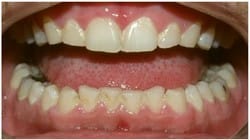 This photo shows teeth shortened by bruxism. This photo shows teeth shortened by bruxism. Of the three causes for tooth loss, the one that surprises most people is excessive bite forces. The American Dental Association says that approximately one in three adults grind their teeth when they sleep. The condition, called bruxism, places unhealthy forces on teeth that can cause flattened or worn-down teeth, chipped areas at the gumline, loose teeth, and damages to your jaw joint. The most frequent causes of bruxism are stress and bite discrepancies. In a healthy bite, the teeth come together in harmony to protect the teeth and your jaw joint. That harmony can be lost when you have periodontal disease, tooth crowding, or missing teeth that have allowed the remaining teeth to shift or tilt. Even if your bite is perfect, stress can cause you to grind your teeth. Of people that are restless sleepers, 95% grind their teeth. The same brain activity that causes you to toss and turn also causes the bruxing. Let’s look at an example of bruxism. In the first photo, the teeth have already been shortened by at least one-fourth of their length. Often patients with problems even this severe are not aware that they are bruxing, and many will even deny it when shown the severity of the problem. And if your spouse sleeps more soundly that you, he or she may also be unaware of the problem. As a dentist, I hear patients make comments like “I sleep with my mouth open, so that can’t be happening.” Bruxing doesn’t occur constantly when you sleep, but if it’s happening, it still will cause damage. Below are some questions that may tell you a problem is present:
One treatment for bruxism is the use of a bite guard. A bite guard is a plastic appliance that fits over your teeth and protects them from damaged that’s caused by grinding. The kind of bite guards sold at the pharmacy can actually make things worse. Custom nightguards can be made that are extremely comfortable, and the newest designs, like the one shown here, actually have a relaxing effect on the muscles. If the arrangement of your teeth lacks harmony, there may be advantages to changing how your bite comes together. Orthodontic treatment (“braces”) can make dramatic changes, or your dentist can use a process called equilibration to reshape the biting surfaces of your teeth to improve the way they come together. Those in and around Fleming County, suffering from tooth grinding and other issues from Bruxism, should contact Dr. William Moorhead, at Flemingsburg Dental care. If you’re suffering headaches, or see tooth wear that you’re concerned about, give us a call at 888-733-3163. Your teeth and your mouth will thank you! |
Articles
All
AuthorDr. Moorhead and his team write about dental news, and answer patient questions. Archives |

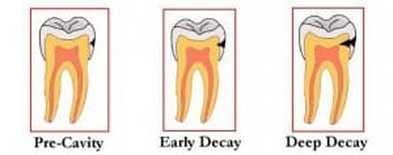
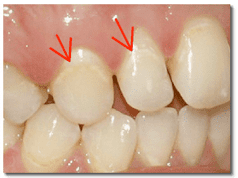
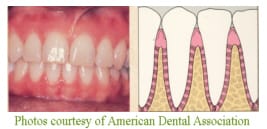
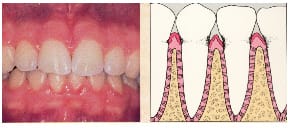
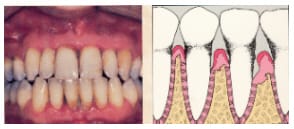
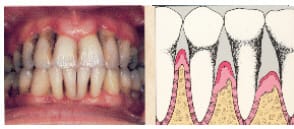

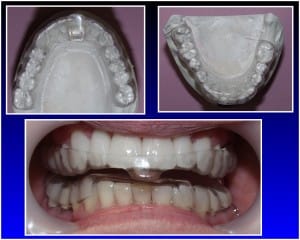
 RSS Feed
RSS Feed